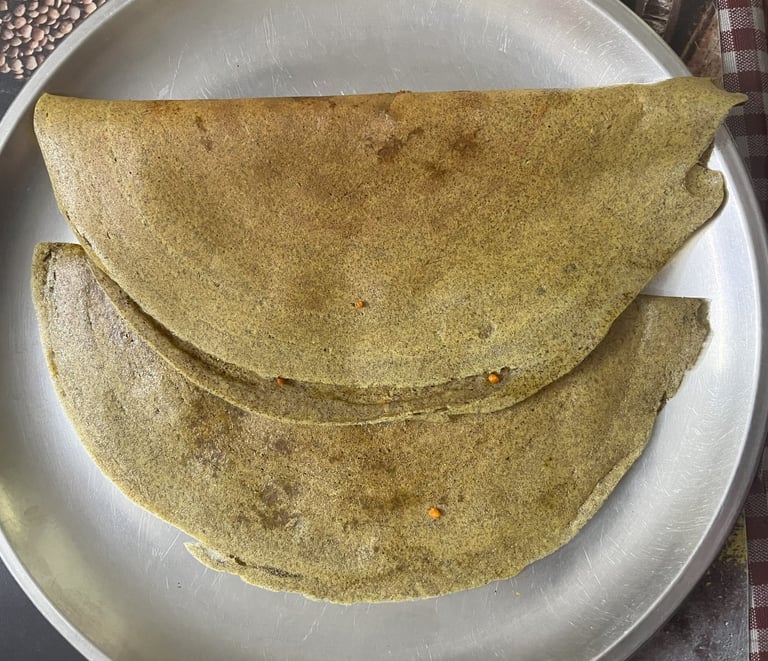Delicious and Nutritious: Gluten-Free Indian-Style Cheela with Finger Millet and Lentils
Homemade Indian-Style crispy cheela with ragi (finger millet) flour and soaked overnight lentils
FOOD
Twinkle Suri
9/16/20244 min read


Cheela: A Traditional Indian Dish
Cheela, a beloved traditional Indian dish, is often enjoyed as a wholesome breakfast or a delightful snack. This savory pancake is typically prepared using various flours, with the uniqueness of each variant stemming from the ingredients employed. One of the most nutritious combinations features finger millet, known as ragi, blended with lentils. This combination not only enhances the flavor but also significantly boosts the nutritional profile of the dish. The cultural significance of cheela in India cannot be understated, as it represents comfort food that is both accessible and versatile, often made in homes across different regions of the country.
The preparation of cheela allows for endless possibilities in terms of taste and texture, accommodating a variety of preferences and dietary requirements. While traditional recipes might utilize wheat flour or besan (gram flour), the growing trend towards gluten-free diets has led to the exploration of alternative ingredients. Finger millet stands out for its health benefits; it is rich in essential nutrients, including calcium, iron, and protein, making it an excellent choice for those seeking a wholesome meal devoid of gluten. The lentils add a further dimension to the dish, supplying additional protein and dietary fiber, thus making cheela a complete meal option. The incorporation of ragi and lentils together not only caters to gluten-sensitive individuals but also promotes overall health. As more people adopt gluten-free lifestyles, exploring traditional foods like cheela presents an opportunity to enjoy delicious and nutritious meals that align with modern dietary preferences. This dish is not only a testament to India's rich culinary heritage but also serves as an example of how traditional foods can adapt to contemporary health trends.
Health Benefits of Finger Millet and Lentils
Finger millet, also known as ragi, boasts an impressive nutritional profile that sets it apart as a superfood. It is particularly rich in essential minerals such as calcium and iron, which are crucial for maintaining strong bones and preventing anemia, respectively. The high calcium content in finger millet makes it an excellent choice for individuals looking to enhance their bone density, particularly in populations at risk of osteoporosis. Furthermore, its iron content aids in the production of red blood cells, contributing to overall cardiovascular health. In addition to its mineral richness, finger millet has a low glycemic index, making it an effective food choice for managing diabetes. Its ability to regulate blood sugar levels is attributable to the high fiber content, which slows down the absorption of glucose in the bloodstream. This characteristic allows individuals with diabetes to incorporate finger millet into their diets without fear of spikes in blood sugar. Additionally, the fiber in finger millet also promotes healthy digestion, alleviating issues such as constipation and enhancing gut health.
Lentils, on the other hand, are legumes that are high in protein, making them an excellent meat substitute for vegetarians and vegans. They are packed with essential amino acids, which are vital for tissue repair and overall bodily functions. Furthermore, lentils are known to support heart health due to their ability to lower bad cholesterol levels and manage blood pressure, thus reducing the risk of heart disease. The presence of soluble fiber in lentils contributes to these cardiovascular benefits while also promoting a feeling of satiety, aiding in weight management.
Incorporating both finger millet and lentils into your diet can thus provide numerous health benefits. These nutrient-dense foods not only enhance overall well-being but also offer a variety of culinary uses, making them a fantastic foundation for a healthy diet.
Ingredients: Making Cheela at Home
Finger millet (ragi) flour - 1 cup
Lentils of choice (urad dal/ moong dal/ masoor dal) - 3/4 cups
Semolina - 1 tbsp
Ghee - 1 tbsp
Curd - 2 tbsp
Cumin seeds - 1/2 tbsp
Green Chilies - 2 nos.
Salt - 2 tbsp/ As per taste
Dried fenugreek leaves - 2 tbsp
Turmeric powder - 1 tbsp
Red chili powder - 1 tbsp/ as per taste
Coriander seeds -1 tbsp
Fresh coriander leaves - a few
You can also add optional add-ons for flavor enhancement like finely chopped onions, tomatoes and indian cottage cheese (paneer) etc.
Preparation:
Soak the lentils in water for at least four hours or overnight, allowing them to soften adequately. Soaking process should be done after the lentils are thoroughly washed with fresh/ tap water at least 3 times.
Once soaked, drain the lentils and rinse them thoroughly.
Heat the ghee in a microwave safe bowl or on the burner/ gas. Put in the ragi flour and roast it for a minute or so (1 minute in the microwave) so as to bring out the nuttiness of the flour.
For batter preparation, blend the soaked lentils with all the ingredients and around 1/2 cup of water until a smooth, thick paste forms.
To achieve the perfect consistency, the batter should not be too runny or too stiff; a thick pouring consistency is desired, like a dosa batter.
Cover the batter and let it rest for about 15-20 minutes while you prepare an iron skillet or non-stick pan. Preheat the skillet on medium heat, then lightly grease it with oil.
Once hot, ladle a portion of the batter onto the skillet, spreading it evenly in a circular motion, similar to making pancakes.
Cook the cheela on medium heat for about 3-4 minutes on one side until the edges begin to lift and turn golden brown. Pour in some ghee for that additional taste. If you are using optional ingredients such as diced onions or tomatoes, this is the stage to incorporate them into the batter.
Flip the cheela carefully using a spatula, adding a bit more oil if necessary, and cook for an additional 1 minute.
Serve the hot cheelas with mint-coriander chutney/ tomato ketchup or butter for a delightful meal.
To cater to different preferences, experimenting with various ingredients directly within the cheela batter will be an interesting experiment. For instance, finely chopped vegetables like spinach, bell peppers, or carrots can be incorporated to add nutritional value and crunch. Additionally, herbs such as cilantro or mint can infuse the dish with a fresh aroma, making each bite more enjoyable. For a heartier meal, cheela filling of sprouted legumes can also be prepared.
Enjoy this warm and comforting meal at home, with a guilt free approach and make it a nutritious meal to enjoy with your family and friends!


